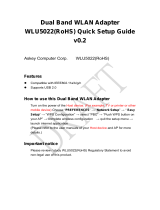Page is loading ...

ASKEY
WIFI Module
WLU6120-D01(RoHS)
WLU6121-D01(RoHS)
OPERATION
MANUAL
DRAFT_V01

1. Product Spec.
Chip Set Atheros AR9271
Operation Voltage 3.3V
Network Standards IEEE802.11b, IEEE802.11g and IEEE802.11n
Modulation Techniques BPSK, QPSK, CCK, DBPSK, DQPSK, 16QAM, 64QAM
Modulation Technology OFDM, CCK, DSSS, MIMO(1T1R)
Data Rate
802.11b: 11, 5.5, 2, 1 Mbps
802.11g: 54, 48, 36, 24, 18, 12, 9, 6Mbps
802.11n:
HT20: 65, 58.5, 52, 39, 26, 19.5, 13, 6.5Mbps(MCS7-0)
HT40: 135, 121.5, 108, 81, 54, 40.5, 27, 13.5Mbps(MCS7-0)
Network Architectures Infrastructure and Ad Hoc
Operating Frequencies 2.412~2.462 GHz
Antenna Type
Antenna 1: RF chain 0 for transmit and receive
Antenna 2: RF chain 1 diversity antenna for receive
RF output power
11b: 16dBm
11g: 16dBm , 15dBm@54M
11n HT20: 16dBm, 13dBm@MCS6, 12dBm@MCS7
HT40:16dBm, 15dBm@MCS5, 11dBm@MCS6, 10dBm@MCS7
Receiver sensitivity
(PER<10%)
802.11b: -82dBm@11Mbps and PER<8%
802.11g: -65dBm@54Mbps and PER<10%
802.11n: HT20-654dBm, HT40:-62dBm
Power Consumption
Tx: 1115mW continuous transmitter 11b @2.4GHz;(1M, 18dBm, 1TX,
IEEE802.11b)
Tx: 1181mW continuous transmitter 11g @2.4GHz;(6M, 18dBm, 1TX,
IEEE802.11g)
Tx: 1184mW continuous transmitter 11n @2.4GHz;(MCS0, 20MHz,
IEEE802.11n)
Tx: 1207mW continuous transmitter 11nb @2.4GHz;( MCS0, 40MHz,
1TX, IEEE802.11n)
Rx: 376mW continuous transmitter 11g @2.4GHz;(1M, IEEE802.11b)
Rx: 379mW continuous transmitter 11g @2.4GHz;(6M, IEEE802.11g)
Rx: 376mW continuous transmitter 11n @2.4GHz;(MCS0, 20MHz,
IEEE802.11n)
Tx: 475mW continuous transmitter 11nb @2.4GHz;( MCS0, 40MHz,
1TX, IEEE802.11n)
Temperatures(AMBIENT) Operation: 0~60 , Storage:-20~70
Humidity(non-condensing) 0~95%RH
Antenna
Ant1: PCB Antenna/ Gain:2.86
Ant2: PCB Antenna/ Gain:2.74
Ant3: PCB Antenna/ Gain:2.19
Ant4: PCB Antenna/ Gain:2.50
Ant5: PCB Antenna/ Gain:0.77

2. Setup Operation
A. Install WLU6120-D01(RoHS) / WLU6121-D01(RoHS) into the system.
B. Setup Driver as blow windows:



USA - Federal Communications Commission (FCC)
FCC Radiation Exposure Statement
CAUTION:
. • The radiated output power of WiFi Module 802.11bgn devices is far below the
FCC radio frequency exposure limits. Nevertheless, WiFi Module 802.11bgn devices
should be used in such a manner that the potential for human contact during normal
operation is minimized. To avoid the possibility of exceeding the FCC radio frequency
exposure limits, you should keep a distance of at least 20 cm between you (or any
other person in the vicinity) and the antenna that is built into the notebook.
Interference Statement
These devices comply with Part 15 of the FCC Rules. Operation of the devices is subject to the
following two conditions: (1) The devices may not cause harmful interference, and (2) The
devices must accept any interference that might cause undesired operation.
This equipment has been tested and found to comply with the limits for a Class B digital device,
pursuant to Part 15 of the FCC Rules. These limits are designed to provide reasonable protection
against harmful interference in a residential installation. This equipment generates, uses, and
can radiate radio frequency energy. If the equipment is not installed and used in accordance with
the instructions, the equipment might cause harmful interference to radio communications.
There is no guarantee, however, that such interference will not occur in a particular installation.
If this equipment does cause harmful interference to radio or television reception (which can be
determined by turning the equipment off and on), the user is encouraged to try to correct the
interference by taking one or more of the following measures:
. • Relocate this device.
. • Increase the separation between the device and the receiver.
. • Connect the device into an outlet on a circuit different from that of other electronics.
. • Consult the dealer or an experienced radio technician for help.
NOTE:
. • WiFi Module 802.11bgn must be installed and used in strict accordance with the
manufacturer's instructions as described in the user documentation that comes with the product.
Any other installation or use will violate FCC Part 15 regulations. Modifications not expressly
approved by ASKEY could void your authority to operate the equipment.
. • The devices must not be co-located or operating in conjunction with any other antenna
or transmitter.

Canada. Industry Canada (IC)
This device complies with RSS210 of Industry Canada.
CAUTION: Exposure to Radio Frequency Radiation. The installer of this radio equipment
must ensure that the antenna is located or pointed such that it does not emit RF field in excess of
Health Canada limits for the general population. Consult Safety Code 6, obtainable from health
Canada’s website www.hc-sc.ca/rpb.
1. This Transmitter must not be co-located or operating in conjunction with any other antenna or
transmitter.
2. This equipment complies with FCC RF radiation exposure limits set forth for an uncontrolled
environment.
3. Any changes or modifications (including the antennas) made to this device that are not expressly
approved by the manufacturer may void the user’s authority to operate the equipment.
This device is intended only form OEM integrators under the following conditions:
1) The transmitter module may not be co-located with any other transmitter or antenna.
IMPORTANT NOTE: In the event that these conditions can not be met (for example certain laptop
configurations or co-location with another transmitter), then the FCC authorization is no longer considered
valid and the FCC ID can not be used on the final product. In these circumstances, the OEM integrator will be
responsible for re-evaluating the end product (including the transmitter) and obtaining a separate FCC
authorization.
End Product Labeling
The final end product must be labeled in visible area with the following:
Contains TX FCC ID: H8N-WLU6120; IC: 1353A-WLU6120
End Product Manual Information
The user manual for end users must include the following information in a prominent location
"IMPORTANT NOTE: To comply with FCC RF exposure compliance requirements, the antenna must not be
co-located or operating in conjunction with any other antenna or transmitter.
Operation is subject to the following two conditions: (1) this device may not cause interference, and (2) this
device must accept any interference, including interference that may cause undesired operation of the
device.
/

